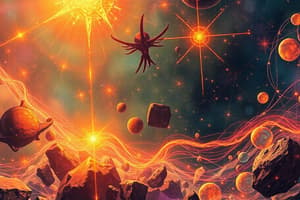Podcast
Questions and Answers
What is spectroscopy?
What is spectroscopy?
The study of interactions between matter and different forms of electromagnetic radiation.
Which of the following are techniques included in atomic spectroscopy? (Select all that apply)
Which of the following are techniques included in atomic spectroscopy? (Select all that apply)
- Atomic Absorption Spectroscopy (AAS) (correct)
- X-ray Fluorescence (XRF) (correct)
- Nuclear Magnetic Resonance Spectroscopy (NMR)
- Atomic Emission Spectroscopy (AES) (correct)
What does AAS exploit?
What does AAS exploit?
Interactions between UV-visible light and the valence electrons of free gaseous atoms.
A neutral atom can only exist at the ground state.
A neutral atom can only exist at the ground state.
In atomic spectroscopy, the major principle of emission and absorption techniques is the formation of atomic ______.
In atomic spectroscopy, the major principle of emission and absorption techniques is the formation of atomic ______.
What is the role of atomization in atomic spectroscopy?
What is the role of atomization in atomic spectroscopy?
What types of light sources are used in atomic spectroscopy instruments?
What types of light sources are used in atomic spectroscopy instruments?
What is a common atomizer used in AAS and AFS?
What is a common atomizer used in AAS and AFS?
What is the typical detection limit for AAS measurements?
What is the typical detection limit for AAS measurements?
Flashcards are hidden until you start studying
Study Notes
Atomic Spectrometry Overview
- Spectroscopy involves studying interactions between matter and electromagnetic radiation; when quantitative analysis is applied, it is referred to as spectrometry.
- Atomic spectroscopy techniques include Atomic Absorption Spectroscopy (AAS), Atomic Emission Spectroscopy (AES), Atomic Fluorescence Spectroscopy (AFS), X-ray Fluorescence (XRF), and Inorganic Mass Spectroscopy (MS).
Basic Principles of Atomic Spectroscopy
- Every element has a unique atomic structure with a positively charged nucleus surrounded by electrons necessary for neutrality.
- Electrons occupy energy orbitals and can transition to higher energy levels by absorbing energy from collisions, light, or high-energy electrons.
- Low energy ground state (E0) and excited states (E′’) depend on electron transitions driven by acquired energy (ΔE).
- Specific light wavelengths entering an analytical system cause electron excitation, reducing the transmitted light amount, characteristic of AAS.
Energy Transitions in Atomic Spectroscopy
- In AAS, light absorption leads to a decrease in transmitted light.
- In AES, excited outer shell electrons emit light when returning to the ground state.
- AFS involves ground state atoms absorbing and later emitting light.
Instrumentation in Atomic Spectroscopy
- Atomization, converting samples into vapor, is fundamental for emission, absorption, and fluorescence techniques.
- Critical components include atomization sources, sample introduction devices, and spectrometers for wavelength selection and light detection.
Atomization Process
- Atomization involves:
- Solvent removal
- Separation of analyte from ions and matrix
- Reduction to ground state atoms
- Atomization technology typically uses flames and electrothermal devices which provide quick measurements with minimal interference.
Light Sources in Atomic Spectroscopy
- Light sources are classified into continuous (broadband) and line sources; continuous sources emit over a range of wavelengths, while line sources emit at specific wavelengths.
- Common lamps used as light sources include various types that provide specific atomic lines needed for analysis.
Flame Atomization
- Flame atomizers consist of components like a pneumatic nebulizer, expansion chamber, and an air-acetylene flame.
- Suitable for AAS and AFS due to straightforward operation; can typically measure concentrations around 1 μg/ml (ppm).
- Advances are being made to improve nebulizer efficiency and achieve 100% atomization, allowing for pulsed sample flow instead of continuous flow.
Electrothermal Atomization
- Graphite tube atomizers utilize electric heating for atomization and can be more effective for certain analyses compared to flame atomization.
Studying That Suits You
Use AI to generate personalized quizzes and flashcards to suit your learning preferences.



